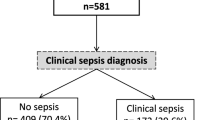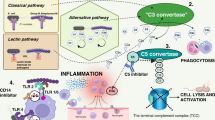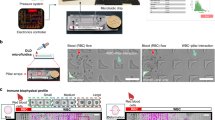Abstract
Background:
Staphylococcus epidermidis (SE) is an important cause of late-onset sepsis in neonates. SE frequently produces a polysaccharide intercellular adhesin (PIA) biofilm, important in the pathogenesis of these infections. Little is known about how the neonatal innate immune system reacts to SE biofilm–associated infections. Our hypothesis was that SE biofilms induce a lower complement activation in neonates as compared with adults.
Methods:
Cord blood from term infants (n = 15) and blood from adults (n = 6) were studied in an ex vivo whole-blood sepsis model. A PIA biofilm–producing strain (SE1457) and its isogenic mutant (M10), producing a non-PIA biofilm, were used.
Results:
Both SE biofilms induced stronger complement activation in adult than in cord blood (P ≤ 0.033). We found lower levels of antibodies toward both PIA (P = 0.002) and the whole bacterium (P = 0.001) in cord vs. adult blood. By contrast, the interleukin-8 (IL-8) and IL-6 secretion were higher in cord than in adult blood (P ≤ 0.002). The PIA biofilm induced stronger complement activation than the non-PIA biofilm.
Conclusion:
We conclude that the neonatal complement system exhibits a maturational deficiency. This may reduce the ability of neonates to combat biofilm-associated SE infections.
Similar content being viewed by others
Log in or create a free account to read this content
Gain free access to this article, as well as selected content from this journal and more on nature.com
or
References
Stoll BJ, Hansen N, Fanaroff AA, et al. Late-onset sepsis in very low birth weight neonates: the experience of the NICHD Neonatal Research Network. Pediatrics 2002;110(2 Pt 1):285–91.
Isaacs D ; Australasian Study Group For Neonatal Infections. A ten year, multicentre study of coagulase negative staphylococcal infections in Australasian neonatal units. Arch Dis Child Fetal Neonatal Ed 2003;88:F89–93.
Rupp ME, Fey PD, Heilmann C, Götz F . Characterization of the importance of Staphylococcus epidermidis autolysin and polysaccharide intercellular adhesin in the pathogenesis of intravascular catheter-associated infection in a rat model. J Infect Dis 2001;183:1038–42.
Rupp ME, Ulphani JS, Fey PD, Bartscht K, Mack D . Characterization of the importance of polysaccharide intercellular adhesin/hemagglutinin of Staphylococcus epidermidis in the pathogenesis of biomaterial-based infection in a mouse foreign body infection model. Infect Immun 1999;67:2627–32.
Stevens NT, Greene CM, O’Gara JP, Humphreys H . Biofilm characteristics of Staphylococcus epidermidis isolates associated with device-related meningitis. J Med Microbiol 2009;58(Pt 7):855–62.
Arciola CR, Gamberini S, Campoccia D, et al. A multiplex PCR method for the detection of all five individual genes of ica locus in Staphylococcus epidermidis. A survey on 400 clinical isolates from prosthesis-associated infections. J Biomed Mater Res A 2005;75:408–13.
Vuong C, Voyich JM, Fischer ER, et al. Polysaccharide intercellular adhesin (PIA) protects Staphylococcus epidermidis against major components of the human innate immune system. Cell Microbiol 2004;6:269–75.
Klingenberg C, Aarag E, Rønnestad A, et al. Coagulase-negative staphylococcal sepsis in neonates. Association between antibiotic resistance, biofilm formation and the host inflammatory response. Pediatr Infect Dis J 2005;24:817–22.
Cerca N, Jefferson KK, Oliveira R, Pier GB, Azeredo J . Comparative antibody-mediated phagocytosis of Staphylococcus epidermidis cells grown in a biofilm or in the planktonic state. Infect Immun 2006;74:4849–55.
Kristian SA, Birkenstock TA, Sauder U, Mack D, Götz F, Landmann R . Biofilm formation induces C3a release and protects Staphylococcus epidermidis from IgG and complement deposition and from neutrophil-dependent killing. J Infect Dis 2008;197:1028–35.
Clark LA, Easmon CS . Opsonic requirements of Staphylococcus epidermidis. J Med Microbiol 1986;22:1–7.
Levy O . Innate immunity of the newborn: basic mechanisms and clinical correlates. Nat Rev Immunol 2007;7:379–90.
Cheung GY, Otto M . Understanding the significance of Staphylococcus epidermidis bacteremia in babies and children. Curr Opin Infect Dis 2010;23:208–16.
Wolach B, Dolfin T, Regev R, Gilboa S, Schlesinger M . The development of the complement system after 28 weeks’ gestation. Acta Paediatr 1997;86:523–7.
Sonntag J, Brandenburg U, Polzehl D, et al. Complement system in healthy term newborns: reference values in umbilical cord blood. Pediatr Dev Pathol 1998;1:131–5.
Pillay V, Savage N, Laburn H . Circulating cytokine concentrations and cytokine production by monocytes from newborn babies and adults. Pflugers Arch 1994;428:197–201.
Strunk T, Temming P, Gembruch U, Reiss I, Bucsky P, Schultz C . Differential maturation of the innate immune response in human fetuses. Pediatr Res 2004;56:219–26.
Ng PC, Li K, Wong RP, et al. Proinflammatory and anti-inflammatory cytokine responses in preterm infants with systemic infections. Arch Dis Child Fetal Neonatal Ed 2003;88:F209–13.
Härtel C, Osthues I, Rupp J, et al. Characterisation of the host inflammatory response to Staphylococcus epidermidis in neonatal whole blood. Arch Dis Child Fetal Neonatal Ed 2008;93:F140–5.
Björkqvist M, Jurstrand M, Bodin L, Fredlund H, Schollin J . Defective neutrophil oxidative burst in preterm newborns on exposure to coagulase-negative staphylococci. Pediatr Res 2004;55:966–71.
Mohamed MA, Cunningham-Rundles S, Dean CR, Hammad TA, Nesin M . Levels of pro-inflammatory cytokines produced from cord blood in-vitro are pathogen dependent and increased in comparison to adult controls. Cytokine 2007;39:171–7.
Salvesen B, Fung M, Saugstad OD, Mollnes TE . Role of complement and CD14 in meconium-induced cytokine formation. Pediatrics 2008;121:e496–505.
Fredheim EG, Granslo HN, Flægstad T, et al. Staphylococcus epidermidis polysaccharide intercellular adhesin activates complement. FEMS Immunol Med Microbiol 2011;63:269–80.
Harboe M, Ulvund G, Vien L, Fung M, Mollnes TE . The quantitative role of alternative pathway amplification in classical pathway induced terminal complement activation. Clin Exp Immunol 2004;138:439–46.
Harboe M, Garred P, Karlstrøm E, Lindstad JK, Stahl GL, Mollnes TE . The down-stream effects of mannan-induced lectin complement pathway activation depend quantitatively on alternative pathway amplification. Mol Immunol 2009;47:373–80.
Sadovskaya I, Faure S, Watier D, et al. Potential use of poly-N-acetyl-beta-(1,6)-glucosamine as an antigen for diagnosis of staphylococcal orthopedic-prosthesis-related infections. Clin Vaccine Immunol 2007;14:1609–15.
Wolbink GJ, Bollen J, Baars JW, et al. Application of a monoclonal antibody against a neoepitope on activated C4 in an ELISA for the quantification of complement activation via the classical pathway. J Immunol Methods 1993;163:67–76.
Ghoshal AK, Soldin SJ . Evaluation of the Dade Behring Dimension RxL: integrated chemistry system-pediatric reference ranges. Clin Chim Acta 2003;331:135–46.
Landor M . Maternal-fetal transfer of immunoglobulins. Ann Allergy Asthma Immunol 1995;74:279–83; quiz 284.
van den Berg JP, Westerbeek EA, van der Klis FR, Berbers GA, van Elburg RM . Transplacental transport of IgG antibodies to preterm infants: a review of the literature. Early Hum Dev 2011;87:67–72.
Fleer A, Gerards LJ, Aerts P, et al. Opsonic defense to Staphylococcus epidermidis in the premature neonate. J Infect Dis 1985;152:930–7.
Krediet TG, Beurskens FJ, van Dijk H, Gerards LJ, Fleer A . Antibody responses and opsonic activity in sera of preterm neonates with coagulase-negative staphylococcal septicemia and the effect of the administration of fresh frozen plasma. Pediatr Res 1998;43:645–51.
Kelly-Quintos C, Kropec A, Briggs S, Ordonez CL, Goldmann DA, Pier GB . The role of epitope specificity in the human opsonic antibody response to the staphylococcal surface polysaccharide poly N-acetyl glucosamine. J Infect Dis 2005;192:2012–9.
Adamkin D, Stitzel A, Urmson J, Farnett ML, Post E, Spitzer R . Activity of the alternative pathway of complement in the newborn infant. J Pediatr 1978;93:604–8.
Tatad AM, Nesin M, Peoples J, et al. Cytokine expression in response to bacterial antigens in preterm and term infant cord blood monocytes. Neonatology 2008;94:8–15.
Brekke OL, Christiansen D, Fure H, et al. Combined inhibition of complement and CD14 abolish E. coli-induced cytokine-, chemokine- and growth factor-synthesis in human whole blood. Mol Immunol 2008;45:3804–13.
Mollnes TE, Brekke OL, Fung M, et al. Essential role of the C5a receptor in E coli-induced oxidative burst and phagocytosis revealed by a novel lepirudin-based human whole blood model of inflammation. Blood 2002;100:1869–77.
Riedemann NC, Neff TA, Guo RF, et al. Protective effects of IL-6 blockade in sepsis are linked to reduced C5a receptor expression. J Immunol 2003;170:503–7.
Conway Morris A, Kefala K, Wilkinson TS, et al. C5a mediates peripheral blood neutrophil dysfunction in critically ill patients. Am J Respir Crit Care Med 2009;180:19–28.
Lappegård KT, Christiansen D, Pharo A, et al. Human genetic deficiencies reveal the roles of complement in the inflammatory network: lessons from nature. Proc Natl Acad Sci USA 2009;106:15861–6.
Riedemann NC, Guo RF, Hollmann TJ, et al. Regulatory role of C5a in LPS-induced IL-6 production by neutrophils during sepsis. FASEB J 2004;18:370–2.
Mack D, Nedelmann M, Krokotsch A, Schwarzkopf A, Heesemann J, Laufs R . Characterization of transposon mutants of biofilm-producing Staphylococcus epidermidis impaired in the accumulative phase of biofilm production: genetic identification of a hexosamine-containing polysaccharide intercellular adhesin. Infect Immun 1994;62:3244–53.
Rupp ME, Ulphani JS, Fey PD, Mack D . Characterization of Staphylococcus epidermidis polysaccharide intercellular adhesin/hemagglutinin in the pathogenesis of intravascular catheter-associated infection in a rat model. Infect Immun 1999;67:2656–9.
Sadovskaya I, Chaignon P, Kogan G, Chokr A, Vinogradov E, Jabbouri S . Carbohydrate-containing components of biofilms produced in vitro by some staphylococcal strains related to orthopaedic prosthesis infections. FEMS Immunol Med Microbiol 2006;47:75–82.
Fure H, Nielsen EW, Hack CE, Mollnes TE . A neoepitope-based enzyme immunoassay for quantification of C1-inhibitor in complex with C1r and C1s. Scand J Immunol 1997;46:553–7.
Mollnes TE . Analysis of in vivo complement activation. In: Herzenberg LA, Weir DM, eds. Weir’s Handbook of Experiental Immunology. vol. 78. Boston, MA: Blackwell Science, 1997.
Mollnes TE, Lea T, Harboe M . Detection and quantification of the terminal C5b-9 complex of human complement by a sensitive enzyme-linked immunosorbent assay. Scand J Immunol 1984;20:157–66.
Acknowledgements
We thank Grethe Bergseth and Judith Krey Ludviksen at the Research Laboratory at Nordland Hospital, Bodø, for excellent technical assistance; staff at the Department of Obstetrics & Gynecology, University Hospital of Northern Norway, for help with recruitment and collection of samples; and the neonates, their parents, and the adult controls for their participation in the study.
Author information
Authors and Affiliations
Corresponding author
Rights and permissions
About this article
Cite this article
Granslo, H., Klingenberg, C., Fredheim, E. et al. Staphylococcus epidermidis biofilms induce lower complement activation in neonates as compared with adults. Pediatr Res 73, 294–300 (2013). https://doi.org/10.1038/pr.2012.193
Received:
Accepted:
Published:
Issue date:
DOI: https://doi.org/10.1038/pr.2012.193



